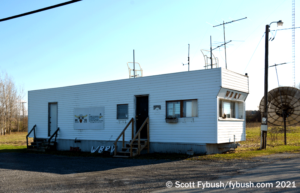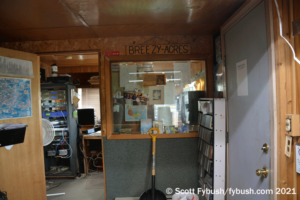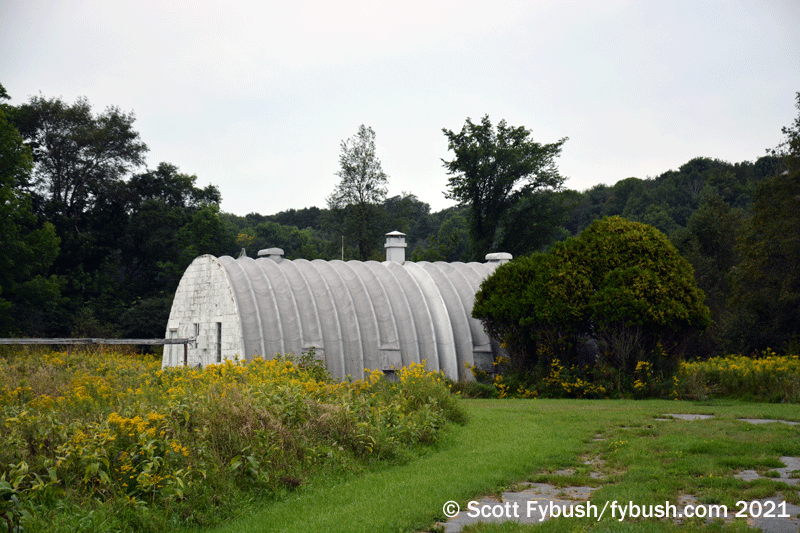NorthEast Radio Watch 12/8/2025: Cichon’s Back in Buffalo
In this week’s issue… Veteran newsman returns - Remembering NY's Leitner, RI's Jones - CT AM saved - Maine AM moves - "Indie" adds suburban signals
Text and photos by SCOTT FYBUSH
With some of our usual more distant travel still impossible in the summer of 2021, we found ourselves digging deeper into some sites around our home turf of upstate New York, sometimes more than once.

The Route 12 corridor between Utica and Watertown is a pleasant bit of scenery that we happened to traverse several times last year. In this week’s Site of the Week, we combine pictures from two of those trips, starting on a very sunny spring day when we worked our way north from Utica toward Watertown.
Just south of Boonville, an old Quonset hut with a wooden fire tower next door was turned into a transmitter site when WBRV-FM (101.3 Boonville) hit the air in 1989, the last part of an expansion that brought Boonville’s heritage AM station, WBRV (900), to the FM dial for the first time.
In 2009, a second FM signal was added to the tower as North Country Public Radio put WXLB (91.3) on the air from a one-bay Shively mounted on a pole attached to the railing of the old fire tower, and then WBRV(AM) added a translator here a few years later on 105.9, from a one-bay antenna mounted above the WBRV-FM antenna.



Flack Broadcasting operates WBRV from two locations: since 1955, the AM 900 transmitter and the studio have been located just north of Boonville on Route 12D. We got some exterior photos in the spring, then returned in the fall to see what’s inside the little trailer that serves as the studio building here.


There are two formats on the air from the studio in the windowed end of the trailer: WBRV-FM (101.3) in Boonville and WLLG (99.3) to the north in Lowville do country as “The Moose,” blanketing the Route 12 corridor with a local morning show and more. WBRV(AM) is classic rock as “The Blizzard,” feeding a network of three FM translators: 103.9 in Rome, 105.9 in Boonville and 98.3 in Lowville.


You want truly local radio? This is a good spot for it – inside this trailer, the walls and windows are lined with memorabilia and history from WBRV’s long run as the hometown voice here in an area that’s otherwise served only by distant radio and TV from Utica and Watertown, plus a couple of very good weekly newspapers.


In the “main office” room where you enter here, there’s a shelf with some little moose models, a nod to the FM stations’ nickname, and a couple of desks looking in to the air studio at the end of the trailer.


It doesn’t take long for Brian “B-Train” Trainor to show us around here, of course – the studio only holds one person a a time, nestled in among the on-air board, the automation systems for all three stations (the two “Moose” FMs can split apart for local sports as needed), and the rack of STL gear that connects the Moose FMs and the Blizzard translators to this site.

Where’s the rest of the Flack operation? To the north in Lowville, where sales and executive offices are upstairs in one of the old brick buildings in the compact downtown part of the village.

There’s one more piece of this facility we didn’t get to see – out back, the AM transmitter is in the quonset hut that was the original 1955 WBRV facility. One of these days, we hope to get back to complete this part of the tour!


Before we move on to Lowville, our fall visit included one very important detour. Before WBRV hit the air in 1955, there had been one previous attempt at radio service in Lewis County. The Rural Radio Network that sprouted across the upstate New York “milkshed” in 1948 included a northernmost station, WVBN (107.7), licensed to Turin and operating from Gomer Hill, the highest point on the snowy Tug Hill Plateau that rises east of Lake Ontario.
While the rest of RRN’s stations were survivors of the early days of FM, all of them still in existence today, WVBN was the odd man out – it didn’t have power lines to its remote site, so it needed expensive generator power. By 1951, its license had been surrendered, never to return. The original WVBN building survived, though, and it’s still here on Gomer Hill, just up the hill from a newer FAA facility. With new siding and a new roof, the old WVBN building is now used by American Tower, with a newer tower having replaced the original 100-foot self-supporter. (Look carefully and you can see where the 1948 tower base still stands, though!)
We’d never been up to this site before, and it’s hard to access in a regular car, but did we mention the fall phase of this trip was in the company of NECRAT‘s Mike Fitzpatrick and his Jeep, which made the drive a lot easier! (Our journey ended up taking us inside another former Rural Radio site, and you’ll see that in this space in a few weeks.)



Back up Route 26 we go, heading to Lowville (“Low” rhymes with “cow” if you want to say it like a native) to see what’s up this way.

Up in the hills southwest of Lowville on Rector Road, we find the WLLG (99.3) site, original to the 1987 sign-on of this half of the “Moose” signals. (The Lowville translator for WBRV AM isn’t here; it’s at a different site east of Lowville.)
Continuing on Route 26 through downtown Lowville and past the Flack Broadcasting business offices, a side road to the east heads up to the local dump and to a tower that hosts two repeater signals. WXLD (89.7) signed on here in 2011 as part of the expansion of the North Country Public Radio network; W220BO (91.9) moved up here in 1999 to improve its relay signal of Syracuse’s Christian station, WMHR.
(Look very carefully at the close-up picture to see the little 91.9 one-bay antenna down below the two-bay WXLD antenna.)
And heading back down County Road 12 to get back on Route 26, we make one more quick stop next to Lewis County Hospital to get a shot of the little translator that lives on the hospital’s roof.
W261CP (100.1), owned by former CBS Radio executive Harvey Nagler, is listed in FCC records as relaying WTOJ from Carthage/Watertown, but we heard it relaying a different station, WLFK (95.3 Gouverneur).

We didn’t expect we’d ever see this one again, but a few months later, the Lewis County hospital made national news because of a shortage of nurses due to its vaccination requirement, and of course we paused the B-roll every time we saw it to point out the little translator antenna on the roof.
From here, we saw even more of the Watertown market – and we’ll show you that, plus a few more North Country stops, next week.

As we announced a few weeks ago, the 2026 edition of the Tower Site Calendar will be the last.
We began publishing it 25 years ago, and the broadcast landscape is radically different now.
Radio World just ran an excellent article about us if you want to know more.
Once it’s gone, that’s it. We won’t be printing any more.
Thank you to everyone who saw our announcement and rushed to buy it. We appreciate you.
(There are some calendars from previous years if you want more of a tower photo fix — all under $5.)
But don’t wait to get this year’s Tower Site Calendar — buy it now!
We are selling the Broadcast Historian’s Calendar again this year, but we have that in an even smaller quantity — definitely don’t hesitate for that.
And visit the Fybush Media Store to check out our selection of books and videos, too!
And don’t miss a big batch of northern New York IDs next Wednesday, over at our sister site, TopHour.com!
Next week: More from the North Country
In this week’s issue… Veteran newsman returns - Remembering NY's Leitner, RI's Jones - CT AM saved - Maine AM moves - "Indie" adds suburban signals
In this week’s issue… Scripps stations face takeover - Sinclair moves more affiliations - CT stations sold - Maine AM surrendered - Remembering WVBR's Shapiro, WABC's Morgan
In this week’s issue… CT TV legend succumbs to cancer - Remembering PA's Adams - FCC still stalled by shutdown - Pittsburgh morning host exits
In this week’s issue… FCC faces reopening challenges - Veteran Boston anchor retires - Morning shift in Toronto - NYC FMs expand reach